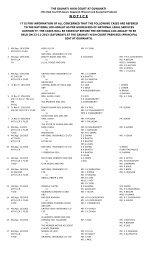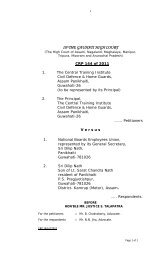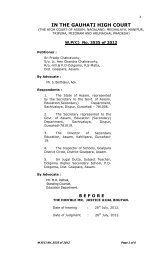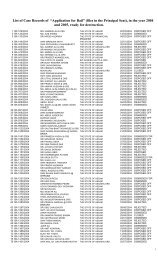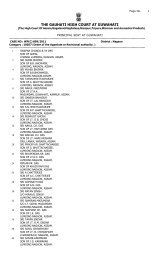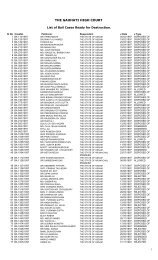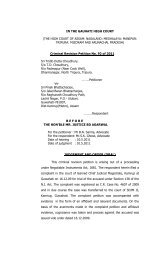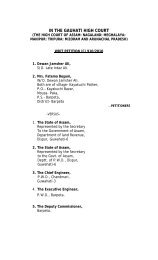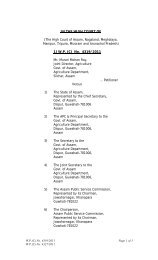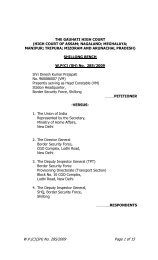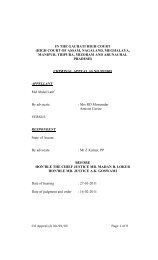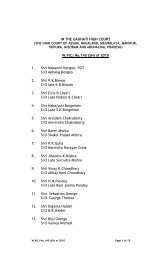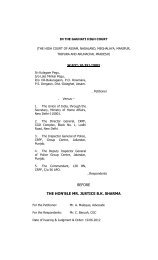You also want an ePaper? Increase the reach of your titles
YUMPU automatically turns print PDFs into web optimized ePapers that Google loves.
1IN THE GAUHATI HIGH COURT(The <strong>High</strong> <strong>Court</strong> of Assam, Nagaland, Meghalaya, Manipur, Tripura,Mizoram and Arunachal Pradesh )<strong>Crl</strong>. Appl <strong>178</strong>/<strong>2010</strong>1. Zil Haque @ Zel,2. Innus Ali,3. Innish Ali Munchi,4. Kashem Ali,5. Abu Hanif,6. Abdul Kalam and7. Sahjamal Ali.The State of AssamVersusAppellants…RespondentsBEFORETHE HON’BLE THE CHIEF JUSTICE MR. A.K. GOELTHE HON’BLE MR. JUSTICE C.R. SARMAFor the appellant : Mr. HRA Choudhury, Sr. Advocate,Mr. I. A. Hazarika, Advocate.For the respondents : Mr. D. Das,Additional Public ProsecutorDate of hearing : 17/2/2012Date of judgment and order : 20/4/2012
2JUDGMENT AND ORDER (CAV)(C.R. Sarma J.)1. This appeal is directed against the judgment and order,dated 30/9/<strong>2010</strong>, passed by the learned Additional Sessions Judge(FTC), Bongaigaon, in Sessions Case No. 30(A)/2007. By theimpugned judgment and order, the learned Sessions Judge, convictedthe appellants, under sections 302/201 read with section 34 IndianPenal Code (hereinafter referred to as the ‘IPC’) and sentenced themto suffer imprisonment for life and pay fine of Rs. 10,000/- each indefault suffer rigorous imprisonment for another period of six monthsfor their conviction under section 302 IPC. The appellants have alsobeen sentenced to suffer rigorous imprisonment for one year and payfine of Rs. 5,000/- each in default suffer rigorous imprisonment foranother period of three months for their conviction under section 201IPC.Aggrieved by the said conviction and sentences, theconvicted persons, as appellants, have come up with this appeal.We have heard Mr. HRA Choudhury, learned Sr. Counselfor the petitioner assisted by Mr. IA Hazarika, learned counselappearing for the appellants and Mr. D. Das, learned Additional PublicProsecutor, Assam, appearing for the State.2. The prosecution case, in brief, as revealed at the trial,may be stated as follows. There was a dispute between the appellantMr. Zil Haque and Md. Tazem Ali (hereinafter referred to as thedeceased) regarding enjoyment of “Aai Nadi Beel” (a river fishery).On 23/5/2004, at about 9 P.M. Md. Najmul Haque (PW7) a covillager,visited the deceased’s house and both of them went out, butthe deceased did not return home. On the next morning, marks ofdragging a person from the house of the appellants namely Innus AliMunchi and Abul Kalam, upto the river was noticed. The people ofthe village, suspecting murder of the deceased and concealment ofthe dead body took steps to fish out the dead body from the river
3water but the dead body could not be recovered on the said date.Accordingly, an FIR was lodged by Amzad Ali (PW1), who is thebrother of the deceased. On the next morning i.e. on 25/5/2004, thedead body of the deceased was found floating in the beel i.e. theplace where search was made on the previous day and informationbeing lodged, Police arrived there and recovered the dead body.During the course of investigation, Police visited the placeof occurrence, recovered the dead body of the deceased, preparedthe inquest report in respect of the dead body (Exhibit 2), prepared asketch map, forwarded the dead body for post mortem examinationand seized a “Punjabi Shirt” from the house of the appellant Innus AliMunchi, vide seizure list (Exhibit-7). Police arrested all the accusedpersons and forwarded them to the <strong>Court</strong>.At the close of investigation, Police submitted chargesheet under sections 302/201/34 IPC against the accused persons.The offence being exclusively triable by the <strong>Court</strong> ofSessions, the learned Sub-Divisional Judicial Magistrate (M), NorthSalmara, Abhayapuri, committed the case to the <strong>Court</strong> of Sessionsand the learned Sessions Judge, Bongaigaon, framed charges, undersections 302/201 read with section 34 IPC, against the appellants.The charges were read over and explained to the accused persons towhich they pleaded not guilty and claimed to be tried.3. In order to prove their case, prosecution examined asmany as 16 witnesses including the Medical Officer (PW16) whoperformed the post mortem examination and the Investigating Officer(PW15). PW1 and PW5 are brothers of the deceased, PW2 is thedeceased’s wife and PW6 is the nephew of the deceased. PW3, PW4,PW7, PW8, PW9, PW10, PW11, PW12, PW13 and PW14 are the covillagersof the deceased.At the close of the evidence for the prosecution, theaccused persons were examined under section 313 Cr.P.C. Theydenied the allegations, levelled against them. No defence evidence
4has been adduced in this case. Considering the evidence on record,the learned Trial Judge convicted and sentenced the appellants asindicated above.4. Mr. HRA Choudhury, learned Sr. Counsel, appearing forthe appellant, has submitted that there is no substantive and reliableevidence indicating the involvement of the appellants with the deathof the deceased and as such the learned Trial Judge committed errorby convicting them under sections 302 and 201 IPC. The learned Sr.Counsel has also contended that the learned Trial Judge failed toappreciate and notice the evidence of the witnesses and thecontradictions, surfacing from their evidence. It is also submitted thatthough PW3 claimed to be the eye witness, he remained silent aboutthe incident for about 45 days and this conduct, on his part, raisesdoubt about the veracity of his testimony. The learned Sr. Counselhas also submitted that no explanation has been given for suchdelayed examination of PW3 by the Police and as such theunexplained delay, in examining such a vital witness, creates doubtabout the veracity of the evidence, given by such witness. Thelearned Sr. counsel has also submitted, that the evidence of PW3cannot be accepted for want of corroboration. He also points out thatthere is no other cogent evidence to substantiate the charge againstthe appellants. The learned Sr. Counsel has further contended thatthe confession alleged to be made by the appellant Zil Haque, duringhis custody with the Police, being hit by section 25 of the IndianEvidence Act, 1872, cannot be used against the appellants. It is alsosubmitted by the learned Sr. Counsel that though a “Punjabi Shirt”has been claimed to be seized from the house of Innus Ali Munchi, onbeing led by Zil Hoque, there is nothing substantive to show that thesaid Punjabi Shirt belonged to the decease. It is also submitted thatthe alleged dragging marks, in the absence of any direct evidence,cannot be sufficient to hold the appellant guilty of causing the deathof the deceased and dragging the dead body to the river for its
5concealment. The learned Sr. Counsel has submitted that theprosecution failed to establish the charges beyond all reasonabledoubt and as such the impugned conviction and sentence are liableto be set aside.Refuting the said arguments, advanced by the learned Sr.Counsel for the appellants, Mr. D. Das, learned Additional PublicProsecutor, has submitted that there is sufficient material, on record,to show that the appellant’s were involved with the death of thedeceased and concealment of the dead body. The learned PublicProsecutor has submitted that the oral evidence given by PW3 andthe dragging marks leading from the house of Innus Ali Munchi andAbul Kamal to the river beel and recovery of the dead body from theriver beel are sufficient substantive evidence to show the involvementof the appellants. He has also submitted that the recovery of thePunjabi Shirt from the house of Innus Ali Munchi, at the instance ofthe appellant Zil Hoque, indicates the involvement of the appellants.In view of the above, the learned Additional PublicProsecutor, supporting the impugned conviction and sentence, hassubmitted that the learned Trial Judge committed no error byconvicting the appellant as indicated above and that the impugnedconviction and sentences do not warrant any interference.5. Having heard the learned counsel for both the parties andconsidering the materials on record, it is found that the dead body ofthe deceased was found floating, on 25/5/2004, in the Aai river beel.The inquest report (Exhbit-2) prepared by the Investigating Officer,after recovery of the dead body from the beel (fishery), reveals thatthe neck was found in swollen condition with two nail marks andthere was bleeding from the nostrils. The Medical Officer (PW16),who performed the autopsy in respect of the dead body of thedeceased did not find any mark of ligature on the neck or injury inthe mouth or on other parts of the body. He opined that death wascaused due to ante mortem drowning. In his cross examination,
6made on behalf of the defence, the Medical Officer stated that he didnot find any injury, even laceration, abrasion, incise, contusion. Healso opined that if any person is dragged, there must be somelaceration or abrasion on the body of the person, who is so draggedand, in that case, skin deep injury would be available. The aboveMedical Evidence rules out the possibility of dragging the deceasedafter causing his death. The absence of any injury includingsuperficial or laceration or abrasion also suggests that no force wasapplied to the deceased either before or after his death. According tothe said Medical Officer, death was caused due to ante mortemdrowning. The expression “ante mortem drowning” used by theMedical Officer rules out the possibility of strangulation or applianceof any force in causing the death. The said medical evidence clearlyindicates that the death of the deceased was due to drowning.Therefore, the medical evidence does not support the prosecutionversion of homicidal death, at the hands of the appellant.Though the prosecution witnesses stated that, on thenext morning, they had seen dragging marks from the house ofInnus Ali Munchi and Abul Kalam to the beel, absence of any injury,on the body of the deceased, does not support the said prosecutionversion that the deceased was dragged from the house of theappellants to the river for its concealment. That apart, if any forcewas applied to the deceased, in causing his death then, certainly,some marks of injury or evidence of applying force would have beenavailable in the body of the deceased. The medical evidence, givenby PW6, indicates absence of any such injury marks. Therefore, itcannot be held that the death of the deceased was caused byapplying any force.6. In the FIR (Exhibit-1), it has been stated that the familymembers of Innus Ali Munchi, Abul Kalam and Md. Abu Hanif (allappellants) whose houses were situated on the road side, heardsome hue and cry or some commotion, on the night of 23/5/2004,
7but they did not come out of their houses. In the FIR, it has alsobeen stated that some dragging marks were found from the place ofoccurrence to the river. The said FIR is silent about the place ofoccurrence. In the FIR, it has not been stated that the draggingmarks were noticed from the houses of Noor Islam and Abdul Kalam.As revealed from the said FIR, it is clear that on the night of23/5/2004, at the time of the incident, Md. Innus Ali, Abdul Kalaamand Abu Hanifa were not present in their respective houses. ButPW3, who claims to be the eye-witness stated that on the said night,while returning from the market, he, along with Innus, Kalaam, JelHaque and Shah Zamaal had gone to the house of Kalaam and thatthe deceased was killed in the house of Kalaam by Jel Haque. In viewof specific statement, made in the FIR, regarding absence of malemembers in the house of Abdul Kalaam, the evidence of PW3 thatthe occurrence had taken place in the house of Abdul Kalaam is notbelievable. According to PW3, when the deceased was going from thehouse of Samsul Dewani (not examined), accused Kalaam had calledhim to his house for taking a paan and in the house of Kalaam, JelHaque had asked the deceased as to whether he would give up thesaid fishery. According to PW3, as the deceased had replied that hewould give up the possession of the fishery as and when the publicwould do that, the appellant Jel Haque had asked him (PW3) andInnus Munchi to move towards the west and thereafter, he heard acry as “o father”. He further stated that accused Jel Haque warnedhim not to disclose the matter to anybody and thereafter the deadbody of the deceased was taken to the fishery. Even if the saidevidence of PW3, is accepted, the involvement of the otherappellants, except Jel Haque, cannot be believed. That apart, he didnot see as to who and in what manner had killed the deceased.7. From his cross-examination, it is found that he did notdisclose such vital information to anybody for about 45 days i.e. tillthe time when he was examined by the Police. Withholding of such
8vital information for such a long period, raises doubt about theauthenticity of the same. No explanation has been put forward by theInvestigating Officer for such delayed examination of PW3. Theunexplained delay in examination of such a vital witness also raisesdoubt about the veracity of the story, revealed by the witness.8. According to PW3, the occurrence took place in the houseof Kamaal and the dead body was taken therefrom to the beel. Sothe dragging marks, if any, should have existed from the house ofAbdul Kalaam. But Md. Parbat Ali (PW5), who was the brother of thedeceased stated that he saw mark of pulling something from thehouse of Innus Munchi to the beel.PW3, who claimed to be an eye witness did not state thatthe incident took place in the house of Innus Munchi. As indicatedabove, according to PW3, the incident took place in the house ofAbdul Kalaam, therefore, if the incident had taken place in the houseof Abdul Kalaam and the dead body was dragged therefrom to thebeel, there could not be any mark of pulling a person from the houseof Innus Munchi.The said evidence of PW5 suggests that the incident tookplace in the house of Innus Munchi, but according to PW3, InnusMunchi was with him at the time of the occurrence and Innus Munchiwas not present, when the appellant Jel Haque had killed thedeceased.The evidence of PW3 is contradicted by Abdul Hamid(PW4), who stated that, on the night of the incident i.e. 23/5/2004 atabout 9 P.M., he heard certain cry in the house of Innus Ali Munchi.Therefore, according to PW4, the incident, had taken place in thehouse of Innus Ali Munchi. Hence, there is discrepancy in theevidence of PW4 and PW3. In tune with the evidence of PW5, Mr.Surut Zamal, deposing as PW6, stated that he saw mark of pullingfrom the house of Innuch Ali Munchi upto the Aai river beel. If theevidence of PW3 is believed then the evidence of PW5 and PW6
9regarding existence of pulling marks from the house of Innus AliMunchi cannot be believed inasmuch as, according to PW3, Innus AliMunchi was present with PW3 at the time of the incident and theincident had taken place in the house of Abdul Kalaam.The said contradictions on material point, found in theevidence of PW3, PW5 and PW6, raises doubt about the veracity ofthe evidence given by the said witnesses. Therefore, the evidence ofPW3 that the incident had taken place in the house of Abdul Kalaamin his presence, cannot be believed without corroboration.None of the prosecution witnesses have corroborated theevidence of PW3 indicating that the incident had taken place in thehouse of Abdul Kalaam.Najmul Haque (PW7), who is stated to have visited thedeceased in his house, supporting the evidence of PW2, stated that,on the fateful night, he went to the house of the deceased and,therefrom he accompanied him for going to the house of Samad Ali(not examined) for discussing a matter regarding purchase of land,but, they went to the house of Samsul Ali (not examined) andtherefrom the deceased, asking this witness to go to the house ofKhalek, proceeded to the house of Sorhab (not examined). So fromthe evidence of PW7, it is found that the deceased, after leaving him(PW7) went to the house of Sorhab for attending a “mel”. If PW7 isbelieved then it must be held that the deceased went to the house ofMr. Sorhab, after coming out from the house of Samsul Ali. Thiswitness further stated that he saw mark of pulling from the house ofInnus Ali Munchi upto the beel. But, if the evidence of PW3 isbelieved then it can be held that, Innus Ali Munchi was with him.Therefore, the deceased, could not have been killed in Innus Ali’shouse and no mark of pulling the deceased from the house of InnusAli Munchi, could have existed.
10Therefore, the evidence of PW3, PW5, PW6 and PW7regarding mark of dragging is found to be contradictory, raisingdoubt about the veracity of their evidence.9. Md. Nabir Hussain (PW8), stated that people had foundmark of dragging a man on the road upto the beel. He did not statethat the dragging mark was traced from the house of either Innus AliMunchi or Abdul Kalaam.He further stated that after about 16-17 days of theoccurrence, Police had arrested Jil Haque and brought him to theplace of occurrence and on being asked by the people, who gatheredthere, the said appellant confessed that he had killed the deceased.However, in his cross examination, this witness stated that he himselfdid not ask the appellant about his involvement.Mahar Ali (PW9), in tune with the evidence of PW8 andPW10 stated that, after arrest of appellant Jil Haque, on being askedby the public, he had confessed his guilt.It is found that the said extra judicial confession wasmade by the accused, while in his custody of the Police i.e. after hisarrest. Therefore, the said extra ordinary judicial confession, if any,being hit by sections 25 and 26 of the Indian Evidence Act, 1872,cannot be accepted as legal evidence against the appellants.Though the Punjabi shirt, belonging to the deceased, isclaimed to be seized, vide Exhibit-7, from the house of Innus AliMunchi, on being led by the appellant Jil Haque, the evidence givenby PW3 negates the involvement of Innus Ali Munchi.The seized shirt has been exhibited by the InvestigatingOfficer (PW15) as material Exhibit-1. None of the prosecutionwitnesses, more particularly, the family members of the deceasedproved that the said material Exhibit-1, was the shirt worn by thedeceased at the relevant time. The wife of the deceased i.e. PW2 andMr. Najmul Hoque (PW7), with whom the deceased had left his housejust before the incident were the best persons to say as to whether
11the deceased had left the house with the said Punjabi Shirt. PW7 issilent with regard to the said material Exhibit-1. Though PW2 i.e. thewife of the deceased stated that the appellant Jil Haque hadproduced her husband’s Punjabi shirt from the house of Innus AliMunchi, she had neither exhibited the said shirt nor stated that thematerial Exhibit No. 1 i.e. the very shirt seized by the Police, wasused by her husband at the relevant time. Therefore, recovery of aPunjabi Shirt from the house of Innus Ali Munchi, at the instance ofthe appellant Jil Haque, cannot be substantive evidence to show thatthe same was kept by the said appellant, after committing the crime.Therefore, the seizure of the said shirt cannot be substantial evidenceto implicate the appellant with the death of the deceased.10. Law is well settled that in a criminal case, the prosecutionis required to prove the charges, brought against accused beyond allreasonable doubt and benefit of such doubt should always go infavour of the accused person. As discussed above, we find that theprosecution failed to prove, beyond all reasonable doubt, that noneother than the appellants had caused the death of the deceased.Therefore, it is not safe to base the conviction, on the basis of theevidence as indicated above.In our considered opinion, the appellants are entitled tothe benefit of doubt. Accordingly we find merit in this appeal,requiring interference with the impugned conviction and sentence.The conviction and sentence as indicated above are set aside. Theappellants are acquitted and they be set at liberty forthwith, if notrequired in any other case.11. For the sake of brevity, without repeating the discussionsmade in the Criminal Appeal No.93 (J) /2005 (disposed of on22.12.2011), with regard to the victim compensation, as provided bySection 357 A Cr.P.C., we make the following directions:(1) As an interim relief, and without prejudice to theright of the dependants of the victim to claim higher amount,
12an amount of Rs.50,000/- be deposited by the StateGovernment with the District Legal Services Authority ofBongaigaon District within a period of two months from thisdate. The District Legal Services Authority, on receipt of thesaid money, shall make an enquiry to ascertain as to whether,there is dependant(s), who suffered loss and injury as a resultof death of the deceased and also if such dependent(s) orlegal representative(s) need any rehabilitation.(2) Upon such enquiry, if it is found that thedependent(s), if any, need rehabilitation, then the DistrictLegal Services Authority shall initially release the said interimamount and thereafter direct payment of adequatecompensation, as may be prescribed by the scheme, to beprepared by the State Government. It is made clear that if theDistrict Legal Services Authority, after due enquiry, arrive atthe findings that there is no dependent(s) or that thedependent(s) of the deceased/victim does not require anyrehabilitation, then the District Legal Services Authority, shallrefund the said amount of Rs.50,000/-, without delay, infavour of the State Government.Let a copy of this judgment and order be furnished to theChief Secretary to the Government of Assam, for doing the needful.12. With the above observations, directions andmodifications, the appeal is allowed.Return the LCRs.RAJUDGECHIEF JUSTICE



